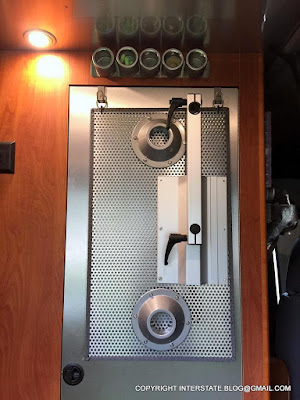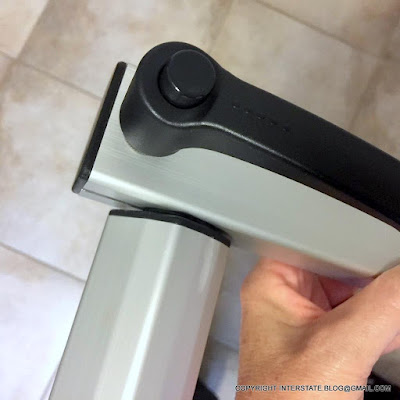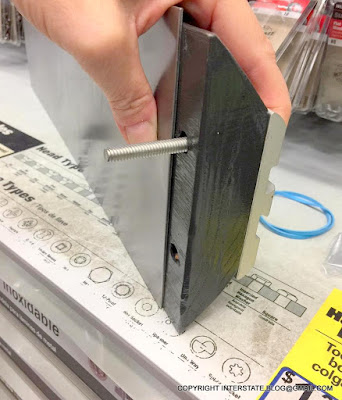 |
| And what a beauty she is. The blog post linked above describes how I repurposed all of Airstream's original hardware for this improved design. |
More accurately, I made a custom computer table top. Which I am now free to deploy elsewhere in the van should it prove to suit my purpose.
And it might, because there is the infernal issue of the dismal ride quality in the rear of the Sprinter where this tricked-out table typically functions (for a tri-forum collection of ride-quality grousing, see discussion threads here and here and here, and I could go on with many more). Try as I might, I have not been able to gain any "sea legs" to help me deal with the constant fish-tailing and pounding roughness of life on the road in our aft section. Sitting back there usually makes me acutely ill inside of 30 minutes unless I spend my entire time staring out the window at the horizon to minimize inner-ear disruptions. That approach, of course, would not be compatible with working on a computer.
Ergo, if I want to be able to work when we are under way, and as a small business owner I very much want to do that, then I have exactly two choices: Either find a way to retrofit rear air suspension to the van, or find another less-punishing place to work.
Air suspension is a pricey option - between $5,000 and $10,000, with the added complexity that out-of-the-box systems are no longer sold for the T1N Sprinter, which is now more than 10 years post-production. Newer systems are not compatible because of chassis changes. The one older system that has the potential to work is the Glide-Rite package sold out of the UK. The problem there is that we would have to fabricate some of our own mounting hardware, as they no longer sell it. That introduces a lot of work, and far more importantly, it introduces technical unknowns into the purchase decision. What if we spent all that money and the installation proved to be more trouble than it was worth? (For instance, we never did confirm whether that system was retrofittable with our propane tank being located where it is).
It dawned on me recently that there may be a workaround. If I could find a way to work at the front of the van instead of at the back of the van, the issue of rear sway and roughness largely becomes moot.
So I set about the process of experimenting with options in this regard. My early efforts tended toward the conventional, and they proved to be unworkable.
And then I remembered -- we installed a seat swivel that we proceeded to hardly ever use. What if I could work up front, but facing the rear insead?
 |
| Remember Southwest Airlines' old lounge seating areas? They were discontinued probably because they were unpopular - many people did not like the idea of flying backwards. I was often the passenger who volunteered to sit in that row, because I did not give a flip which way my seat faced. Image courtesy of Airliners.net. |
 |
| Maybe that swivel seat could be used for a task more productive than map reading. |
The question then became -- if I were to use my computer table here, how would it be mounted?
We really didn't like the idea of sinking two additional leg receivers into the floor at this location, right in the way of traffic. They may be close to being flush with the floor surface, but those holes are a pain the ass, plus I find them unsightly.
 |
| Nope. I think it would require tapping into the chassis, which I absolutely do not want to do. Image from this site. |
I got the Lagun table idea from the forum poster known as GeorgeRa, whose self-built van is named Voila (see if this link to a photo album, and see also here and here). The Lagun is sold by a company named Marine Teak.
If you look at the installation pics that are available on those threads linked above, you will notice one regrettable design feature: the Lagun hardware has to be mounted substantially proud of any vertical surfaces that might otherwise interfere with the table's swivel function.
 |
| Marine Teak's facility in the UK. Notice that solar camper van near lower right. Clearly, its presence was A Sign. |
 |
| GeorgeRa's installation, with the table top and arm being in the stowed position. Not too bad, but you can see that he extended his cabinet mount with what looks like a rectangular block of wood. |
The reason why these bump-outs are necessary has to do with this:
 |
| It arrived from Merry Old England as an undisturbed bundle of joy. |
If I have to concede the use of a mounting adapter, I at least want something a bit more elegant and a bit less bruising than some of the published variants. So I fashioned an alternative with aspects of quality and appearance in mind.
 |
| Solid red oak, with a beveled edge. |
But God forbid I should be able to purchase a single piece of oak thick enough for this job. No - I had to get two and sandwich them as shown above. This was the first of several successive First World miseries associated with this project. I don't mind doing projects - in fact, I really enjoy projects. What I do not enjoy is not being able to easily buy the basic feedstocks that I need for the projects.
Here's the next pain in the ass where hardware was concerned.
To make matters worse, in ordering this from Merry Old England, of course it came with metric hardware. Metric stainless countersunk bolts, to be specific. I might as well be seeking to buy a lock of hair that had been taken from Christ Himself.
The bolt length matters because of the backing plate that was delivered with the Lagun. It was made of half-inch plywood so it was going to add considerable thickness to the overall fastener design. Of course I could order the optimal hardware for this job off the internet, but if I did that every time I needed a specific item, it would be a month of Sundays before I got anything finished. So typically what happens is that I make do with whatever crap can be located in big box stores.
 |
| This is what the OEM half-inch plywood backer looked like once I painted it and trimmed it sufficiently to fit in our space. |
 |
| This is the view inside the cabinetry. The installation kit did not come with the fender washers. We added those. |
 |
| You know a project was successful when you sit in the midst of it and you don't want to get back up again. |
 |
| Most importantly, the table does not impinge upon the dog's space. |
 |
| View from the side. Yes, I know I need a foot rest. The swivel mechanism has the effect of raising the seat. |
 |
| In order to get up without removing the table, I just push it away, and then swivel it to the side. |
 |
| I get a great view from this location, too. And I get my dog's full attention when the dinner hour approaches. |
 |
| Same thing I did with the original table top - hang it on the outside of the wet bath door. |
Like I always say, our van keeps getting bigger and bigger. I just doubled both my working options and my comfort level, because now I can sit in a full captain's chair instead of perching on the couch to do computer work.
Stay tuned for my road testing notes.
 |
| No, actually, I don't. The office on wheels that I have is constantly on the improve. |
UPDATE 20180510: Those sharp corners were proving to be a pain now that the table is mobile and swiveling, so they were trimmed and the edge re-bound as follows, which I expect will furnish a significant ergonomic improvement:













No comments:
Post a Comment